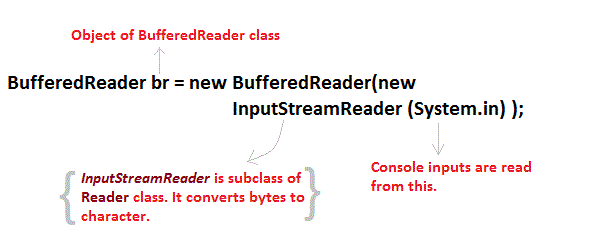

- #Simple reader and simple writer in java purpose how to#
- #Simple reader and simple writer in java purpose code#

Know what a string refers to in programming. Here we are going to present a simple use case of StringWriter. Learning Objectives Learn to write a program that reads text written by a user. The changes will be reflected in the StringWriter. StringBuffer sbuf = outputWriter.getBuffer() Īs you can see you can obtain the StringBuffer and use it normally. Custom Library and File Read/Write, use our new - Advanced Java IDE. Here you can see how you can obtain and use the output buffer of the StringWriter in the form of a StringBuffer. Online Java Compiler - Online Java Editor - Online Java IDE - Java Coding Online. Since Reader is an abstract class, it is not useful. Here you can use write method to write a sub string of the output String: The Reader class of the java.io package is an abstract superclass that represents a stream of characters. It has several methods that let you print any data type values. And then we’ve used toString to obtain the contents of the output buffer in the form of a String. We can use PrintStream class to write a file.
#Simple reader and simple writer in java purpose how to#
The following program depicts how to create a text file using FileWriter Java import java.io.
#Simple reader and simple writer in java purpose code#
BufferedWriter can be used along with FileWriter to improve the speed of execution. One class contains all the properties, fields and methods while the other class contains a main() method in which we write the code which has to be executed. (outputWriter.toString()) Īs you can see from the above example, we’ve basically used two StringWriter class methods : write and append which basically do the same thing, they append a string or a single character to the output stream (the string buffer). Reading and writing take place character by character, which increases the number of I/O operations and affects the performance of the system. Character streams will allow us to read or write data character by. Hence these classes fall under character streams. We will also learn about FileWriter and FileReader classes in Java. To learn more, visit Java Writer (official Java documentation). output.write() // To write data to the file output.close() // To close the writer When we run the program, the output.txt file is filled with the following content. In this Java tutorial, first of all, we will learn about reading and writing a file in Java. To write data to the output.txt file, we have implemented these methods. StringWriter outputWriter = new StringWriter() Reading and writing a file in java using FileWriter and FileReader. StringWriter is a subclass of java.io.Writer and can be used to write character streams in a String buffer and later can be used to obtain the stream as a String and even obtain the output buffer as a StringBuffer. Though internally FileReader uses FileInputStream and FileWriter uses FileOutputStream but here the major difference is that FileReader reads two bytes at a time and FileWriter writes two bytes at a time.įollowing example, which makes the use of these two classes to copy an input file (having unicode characters) into an output file − Example import java.io.In this example we are going to see how to use StringWriter. It warps another Reader and adds a buffer that will read the text much faster and improves performance by buffering input. Though there are many classes related to character streams but the most frequently used classes are, FileReader and FileWriter. This method is declared as abstract method. It has reached the end of the stream while reading. This method blocks the stream till: It has taken some input from the stream. Java Byte streams are used to perform input and output of 8-bit bytes, whereas Java Character streams are used to perform input and output for 16-bit unicode. The read () method of Reader Class in Java is used to read a single character from the stream.


 0 kommentar(er)
0 kommentar(er)
